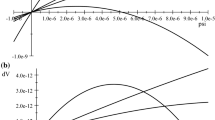Abstract
This paper studies aggregation and a weak form of optimality referring to the p-weakly constrained Pareto efficiency (p-WE) in stochastic finance economies with incomplete markets. We derive a representative agent utility function maximized at equilibrium and a characterization of the set of p-WE allocations. Moreover, we establish the correspondence between the set of competitive equilibrium allocations and the set of p-WE allocations. It is noted that these are accomplished for general time-state utility functions and without restrictions on the initial resource allocations.
Similar content being viewed by others
References
Arrow K, Debreu G (1954) Existence of an equilibrium for a competitive economy. Econometrica 22: 265–292
Balasko Y (1979) Budget-constrained Pareto-efficient allocations. J Econ Theory 21: 359–379
Balasko Y (1982) Budget-constrained Pareto-efficient allocations: a dynamic story. J Econ Theory 27: 239–242
Detemple J, Gottardi P (1998) Aggregation, efficiency and mutual fund separation in incomplete markets. Econ Theory 11: 443–455
Diamond P (1967) The role of a stock market in a general equilibrium model with technological uncertainty. Am Econ Rev 57: 759–776
Duffie D, Shafer W (1985) Equilibrium in incomplete markets I: basic model of generic existence. J Math Econ 14: 258–300
Duffie D, Shafer W (1986) Equilibrium in incomplete markets II: generic existence in stochastic economies. J Math Econ 15: 199–216
Eisenberg B (1961) Aggregation of utility functions. Manag Sci 7: 337–350
Geanakoplos J, Polemarchakis H (1986) Existence, regularity and constrained suboptimality of competitive allocations when markets are incomplete. In: Heller WP, Ross RM, Starrett DA (eds) Uncertainty, information and communication: essays in honor of Kenneth Arrow, vol 3. Cambridge University Press, Cambridge
Geanakopolos J, Shafer W (1990) Solving systems of simultaneous equations in economics. J Math Econ 19: 69–93
Gorman W (1953) Community preference fields. Econometrica 21: 63–80
Grossman S (1977) A characterization of the optimality of equilibrium in incomplete markets. J Econ Theory 15: 1–16
Hart O (1975) On the optimality of equilibrium when the market structure is incomplete. J Econ Theory 11: 418–443
Kreps D (1990) A course in microeconomics theory. Prentice Hall, Harlow
Magill M, Quinzii M (1996) Theory of incomplete markets. MIT, Cambridge
Magill M, Shafer W (1990) Characterization of generically complete real asset structures. J Math Econ 19: 167–194
Mas-Colell A (1985) A theory of general economic equilibrium. Cambridge University Press, Cambridge
Milne F (1979) Consumer preferences, linear demand functions and aggregation in competitive asset markets. Rev Econ Stud 50: 407–417
Negishi T (1960) Welfare economics and existence of an equilibrium for a competitive economy. Metroeconomica 12: 92–97
Ohlson J (1987) The theory of financial markets and information. North-Holland, Amsterdam
Radner R (1972) Existence of equilibrium of plans, prices and price expectations in a sequence of markets. Econometrica 40: 289–304
Rubinstein M (1974) An aggregation theorem for securities markets. J Finan Econ 1: 225–244
Shapiro P (1977) Aggregation and the existence of a social utility function. J Econ Theory 16: 475–480
Svensson L (1984) The existence of budget-constrained Pareto-efficient allocations. J Econ Theory 32: 346–350
Wilson R (1968) The theory of syndicates. Econometrica 36: 119–132
Author information
Authors and Affiliations
Corresponding author
Rights and permissions
About this article
Cite this article
Ma, C., Zhang, J. p-Weakly constrained Pareto efficiency and aggregation in incomplete markets. Soc Choice Welf 41, 605–623 (2013). https://doi.org/10.1007/s00355-012-0695-x
Received:
Accepted:
Published:
Issue Date:
DOI: https://doi.org/10.1007/s00355-012-0695-x




